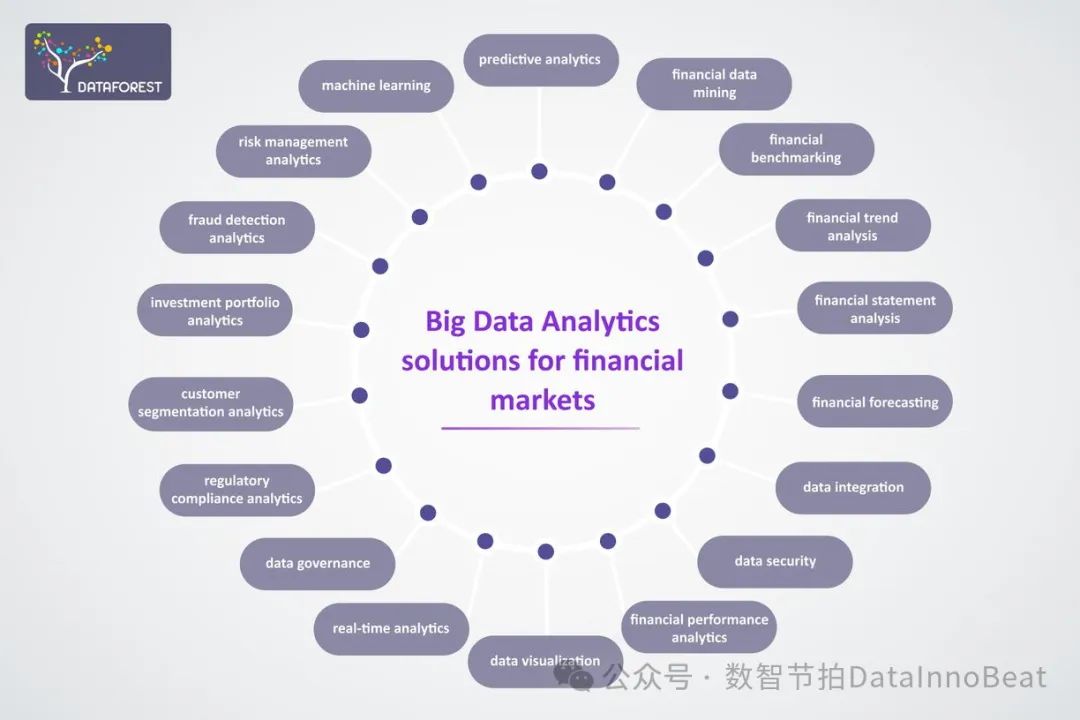1. 风控与信用评估
应用场景:通过大数据分析和机器学习,金融机构能够整合客户的行为、财务、社交数据,建立全面的风险管理模型,实现精准的信用评估。
Scenario: Financial institutions use big data analytics and machine learning to integrate customer behavior, financial, and social data, building comprehensive risk management models for precise credit evaluations.
案例:例如,芝麻信用通过用户的网购行为、社交互动、借款记录等数据,为用户生成信用评分,帮助贷款机构快速评估用户的还款能力。用户的信用分还可以用于生活中的多种场景,如租房、共享单车免押金服务。
Use Case: For instance, Sesame Credit uses data from users’ online shopping behavior, social interactions, and borrowing history to generate a credit score, helping lenders quickly assess the user’s repayment capacity. These credit scores can also be applied in daily scenarios like renting apartments or waiving deposits for shared bikes.
2. 智能投顾与资产管理
应用场景:数据分析帮助智能投顾平台为客户提供个性化的资产配置建议,利用市场数据和客户风险偏好进行投资策略调整,提供自动化的投资管理服务。
Scenario: Data analytics helps robo-advisory platforms provide personalized asset allocation recommendations, using market data and client risk preferences to adjust investment strategies and offer automated investment management services.
案例:Wealthfront和Betterment等智能投顾平台通过分析全球金融市场数据、客户的年龄、收入、风险承受能力等,动态调整投资组合,优化客户收益。这些平台还能够根据市场变化实时调整投资策略,帮助客户规避风险并抓住机会。
Use Case: Robo-advisory platforms like Wealthfront and Betterment analyze global financial market data, client age, income, and risk tolerance to dynamically adjust portfolios and optimize returns. These platforms can also adjust investment strategies in real time, helping clients mitigate risks and seize opportunities based on market fluctuations.
3. 个性化营销与精准获客
应用场景:通过分析客户的交易历史、社交行为、地理位置等数据,金融机构可以为不同的客户群体定制个性化的产品和服务,提升客户黏性和转化率。
Scenario: By analyzing customer transaction history, social behavior, and geolocation data, financial institutions can tailor personalized products and services to different customer segments, increasing customer retention and conversion rates.
案例:花旗银行通过分析客户的信用卡消费模式、购买习惯和财务数据,进行细致的客户分类,并向高净值客户提供定制的理财产品,同时向年轻用户推荐更符合其需求的信用卡服务。这种精准营销策略显著提高了客户的满意度和忠诚度。
Use Case: Citibank analyzes customer credit card spending patterns, purchasing habits, and financial data to perform detailed customer segmentation. It offers customized wealth management products to high-net-worth clients while recommending credit card services tailored to younger users. This targeted marketing approach has significantly improved customer satisfaction and loyalty.
4. 客户体验优化
应用场景:金融机构通过大数据分析客户在不同服务渠道(如APP、网站、线下网点)的互动数据,优化服务流程,提供更个性化的客户体验。
Scenario: Financial institutions analyze customer interaction data from various service channels (e.g., app, website, physical branches) to optimize service processes and provide more personalized customer experiences.
案例:美国银行通过分析客户使用其移动应用程序的行为数据,发现用户在某些功能上遇到了困难,银行据此优化了界面设计,并推出了更加智能化的客户服务工具,极大提升了客户满意度和使用频率。
Use Case: Bank of America analyzed customer behavior data from its mobile app and identified challenges users faced with certain features. The bank then optimized the interface design and launched more intelligent customer service tools, greatly enhancing customer satisfaction and usage frequency.
5. 金融产品创新
应用场景:金融机构通过数据洞察,基于客户需求和市场趋势创新金融产品。例如,结合大数据和人工智能推出动态定价的贷款产品或个性化的保险服务。
Scenario: Financial institutions leverage data insights to innovate financial products based on customer needs and market trends. For instance, they can launch dynamically priced loan products or personalized insurance services by combining big data and artificial intelligence.
案例:平安保险通过分析客户的健康数据和日常行为,推出了定制化的健康保险产品。比如,“平安好医生”应用通过采集用户的步数、饮食习惯等信息,给予用户健康管理建议,并调整保险费率,使得保险更加个性化和灵活。
Use Case: Ping An Insurance uses customer health data and daily behavior analysis to launch customized health insurance products. For instance, the “Ping An Good Doctor” app collects user data such as step counts and dietary habits to offer health management suggestions and adjust insurance premiums, making the insurance more personalized and flexible.
6. 反洗钱与合规管理
应用场景:通过大数据技术,金融机构能够实时监测和分析海量的交易数据,识别异常交易模式,防范洗钱活动,并确保符合国际和本地法规。
Scenario: With big data technology, financial institutions can monitor and analyze massive amounts of transaction data in real-time, identify suspicious transaction patterns, prevent money laundering, and ensure compliance with international and local regulations.
案例:汇丰银行通过大数据监控系统分析全球数百万笔交易,及时发现潜在的洗钱行为。该系统能够识别出复杂的资金流转模式,从而防止非法资金通过不同国家的账户进行转移,确保银行业务合规。
Use Case: HSBC uses a big data monitoring system to analyze millions of global transactions and promptly identify potential money laundering activities. The system can detect complex fund transfer patterns, preventing illicit money from moving across countries via different accounts, ensuring compliance with regulations.
7. 金融市场分析与预测
应用场景:通过实时监控市场数据和经济指标,金融机构可以预测市场趋势,帮助投资者做出更明智的投资决策,规避市场风险。
Scenario: By monitoring real-time market data and economic indicators, financial institutions can forecast market trends, helping investors make more informed investment decisions and avoid market risks.
案例:高盛通过大数据分析和自然语言处理技术,实时追踪全球金融新闻、政府政策和市场情绪,预测股票、外汇等市场的波动。这种前瞻性的分析为机构投资者提供了更有力的市场判断依据,提升了投资回报。
Use Case: Goldman Sachs uses big data analytics and natural language processing to track global financial news, government policies, and market sentiment in real-time, predicting fluctuations in stock and foreign exchange markets. This forward-looking analysis provides institutional investors with stronger market judgment, improving investment returns.
8. 供应链金融
应用场景:数据分析帮助金融机构为供应链中的中小企业提供金融服务,基于交易数据和物流数据评估其信用风险,快速提供贷款或融资服务。
Scenario: Data analysis helps financial institutions provide financial services to small and medium-sized enterprises (SMEs) in the supply chain by assessing credit risk based on transaction and logistics data, enabling quick loan or financing services.
案例:京东金融通过分析供应链上的订单数据、支付记录和物流信息,为供应商提供信用评估和贷款服务。该系统能够根据实际交易量调整贷款额度,帮助中小企业快速获得资金,推动业务增长。
Use Case: JD Finance analyzes order data, payment records, and logistics information within the supply chain to provide credit assessment and loan services for suppliers. The system adjusts loan amounts based on actual transaction volume, helping SMEs quickly access funds and drive business growth.
9. 保险风险定价与赔付管理
应用场景:大数据和人工智能技术帮助保险公司实现更精准的风险定价和更快速的理赔管理,从而提升客户体验并降低运营成本。
Scenario: Big data and AI technologies help insurance companies achieve more accurate risk pricing and faster claims management, enhancing customer experience and reducing operational costs.
案例:美国的Progressive Insurance利用车辆数据监测驾驶员的行为,进而调整汽车保险的费率。好司机可以享受更低的保费,而风险较高的驾驶员则需要支付更高的保费,这种基于数据的定价方式提高了公平性和准确性。
Use Case: Progressive Insurance in the U.S. monitors driver behavior using vehicle data and adjusts auto insurance premiums accordingly. Good drivers enjoy lower premiums, while higher-risk drivers pay more, making the data-driven pricing model fairer and more accurate.
10. 跨境支付与汇兑服务
应用场景:通过大数据和区块链技术,金融机构可以优化跨境支付流程,减少中间环节,降低成本并加速交易速度,提升客户的支付体验。
Scenario: Through big data and blockchain technology, financial institutions can optimize cross-border payment processes, reduce intermediaries, lower costs, and accelerate transaction
**案例:**Ripple使用区块链技术简化了跨境支付流程,允许用户在几秒钟内完成不同货币间的资金转移。这不仅大幅降低了跨境支付的成本,还减少了交易时间和结算风险,提升了全球支付系统的效率。
Use Case: Ripple uses blockchain technology to simplify cross-border payment processes, allowing users to transfer funds between different currencies in seconds. This significantly reduces the cost of cross-border payments, shortens transaction time, and lowers settlement risk, enhancing the efficiency of the global payment system.
如何学习大模型 AI ?
由于新岗位的生产效率,要优于被取代岗位的生产效率,所以实际上整个社会的生产效率是提升的。
但是具体到个人,只能说是:
“最先掌握AI的人,将会比较晚掌握AI的人有竞争优势”。
这句话,放在计算机、互联网、移动互联网的开局时期,都是一样的道理。
我在一线互联网企业工作十余年里,指导过不少同行后辈。帮助很多人得到了学习和成长。
我意识到有很多经验和知识值得分享给大家,也可以通过我们的能力和经验解答大家在人工智能学习中的很多困惑,所以在工作繁忙的情况下还是坚持各种整理和分享。但苦于知识传播途径有限,很多互联网行业朋友无法获得正确的资料得到学习提升,故此将并将重要的AI大模型资料包括AI大模型入门学习思维导图、精品AI大模型学习书籍手册、视频教程、实战学习等录播视频免费分享出来。

第一阶段(10天):初阶应用
该阶段让大家对大模型 AI有一个最前沿的认识,对大模型 AI 的理解超过 95% 的人,可以在相关讨论时发表高级、不跟风、又接地气的见解,别人只会和 AI 聊天,而你能调教 AI,并能用代码将大模型和业务衔接。
- 大模型 AI 能干什么?
- 大模型是怎样获得「智能」的?
- 用好 AI 的核心心法
- 大模型应用业务架构
- 大模型应用技术架构
- 代码示例:向 GPT-3.5 灌入新知识
- 提示工程的意义和核心思想
- Prompt 典型构成
- 指令调优方法论
- 思维链和思维树
- Prompt 攻击和防范
- …
第二阶段(30天):高阶应用
该阶段我们正式进入大模型 AI 进阶实战学习,学会构造私有知识库,扩展 AI 的能力。快速开发一个完整的基于 agent 对话机器人。掌握功能最强的大模型开发框架,抓住最新的技术进展,适合 Python 和 JavaScript 程序员。
- 为什么要做 RAG
- 搭建一个简单的 ChatPDF
- 检索的基础概念
- 什么是向量表示(Embeddings)
- 向量数据库与向量检索
- 基于向量检索的 RAG
- 搭建 RAG 系统的扩展知识
- 混合检索与 RAG-Fusion 简介
- 向量模型本地部署
- …
第三阶段(30天):模型训练
恭喜你,如果学到这里,你基本可以找到一份大模型 AI相关的工作,自己也能训练 GPT 了!通过微调,训练自己的垂直大模型,能独立训练开源多模态大模型,掌握更多技术方案。
到此为止,大概2个月的时间。你已经成为了一名“AI小子”。那么你还想往下探索吗?
- 为什么要做 RAG
- 什么是模型
- 什么是模型训练
- 求解器 & 损失函数简介
- 小实验2:手写一个简单的神经网络并训练它
- 什么是训练/预训练/微调/轻量化微调
- Transformer结构简介
- 轻量化微调
- 实验数据集的构建
- …
第四阶段(20天):商业闭环
对全球大模型从性能、吞吐量、成本等方面有一定的认知,可以在云端和本地等多种环境下部署大模型,找到适合自己的项目/创业方向,做一名被 AI 武装的产品经理。
- 硬件选型
- 带你了解全球大模型
- 使用国产大模型服务
- 搭建 OpenAI 代理
- 热身:基于阿里云 PAI 部署 Stable Diffusion
- 在本地计算机运行大模型
- 大模型的私有化部署
- 基于 vLLM 部署大模型
- 案例:如何优雅地在阿里云私有部署开源大模型
- 部署一套开源 LLM 项目
- 内容安全
- 互联网信息服务算法备案
- …
学习是一个过程,只要学习就会有挑战。天道酬勤,你越努力,就会成为越优秀的自己。
如果你能在15天内完成所有的任务,那你堪称天才。然而,如果你能完成 60-70% 的内容,你就已经开始具备成为一名大模型 AI 的正确特征了。
这份完整版的大模型 AI 学习资料已经上传CSDN,朋友们如果需要可以微信扫描下方CSDN官方认证二维码免费领取【保证100%免费】

























 2682
2682

 被折叠的 条评论
为什么被折叠?
被折叠的 条评论
为什么被折叠?








